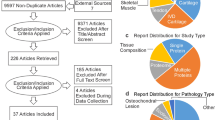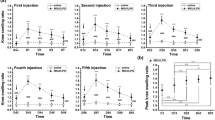Abstract
Previous in vitro experiments on synovial metabolism have shown that the presence of rheumatoid disease in the synovial membrane resulted in marked metabolic changes1. The rate of uptake of oxygen was greatly altered by the presence of the disease, for example, normal synovium (of traumatic origin) Q O 2 (N) 1.0 up to Q O 2 (N) 35.0 in very active disease states. A crude relationship was found to exist between the macroscopic appearance of the pathological material and the rate of uptake of oxygen. As the change in uptake of oxygen was so marked in the rheumatoid synovia, we felt that some quantitative relationship might exist between the rate of uptake of oxygen and the state of the disease. The problem, therefore, was to obtain a quantitative method for expressing the pathological changes in the diseased synovium.
This is a preview of subscription content, access via your institution
Access options
Subscribe to this journal
Receive 51 print issues and online access
$199.00 per year
only $3.90 per issue
Buy this article
- Purchase on Springer Link
- Instant access to full article PDF
Prices may be subject to local taxes which are calculated during checkout
Similar content being viewed by others
References
Page Thomas, D. P., and Dingle, J. T., Biochem. J., 68, 231 (1958).
Herdan, G., “Statistics of Therapeutic Trials”, 247 (Elsevier Pub. Co., Amsterdam, 1958).
Dingle, J. T., and Page Thomas, D. P., Brit. J. Exp. Path., 37, 318 (1956).
Author information
Authors and Affiliations
Rights and permissions
About this article
Cite this article
THOMAS, D., DINGLE, J. Entropy and Synovial Pathology. Nature 183, 543–544 (1959). https://doi.org/10.1038/183543a0
Issue Date:
DOI: https://doi.org/10.1038/183543a0
Comments
By submitting a comment you agree to abide by our Terms and Community Guidelines. If you find something abusive or that does not comply with our terms or guidelines please flag it as inappropriate.



